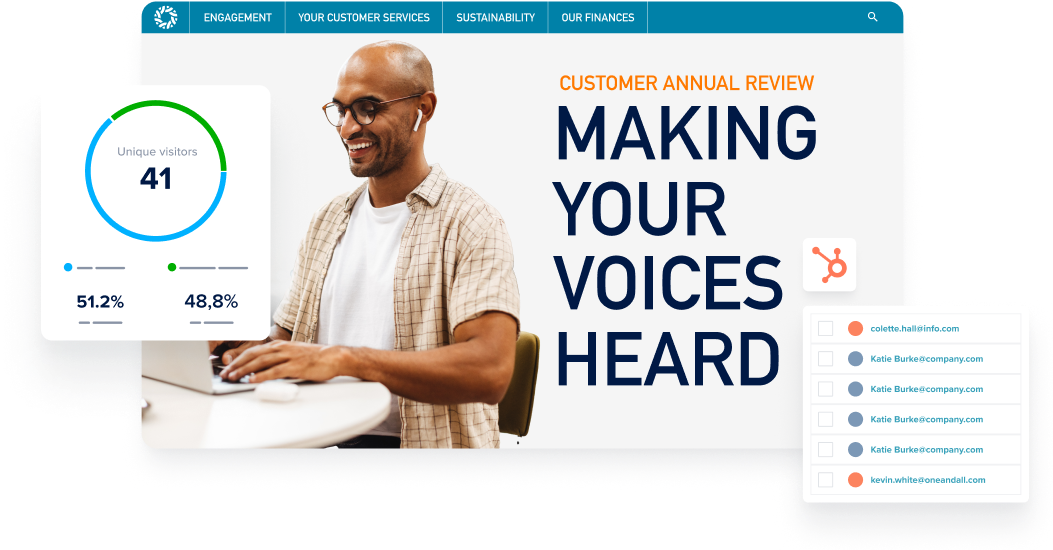The customer journey is the cornerstone of any business’s success.
It's not enough to offer a great product or service; the experience you provide throughout a customer's interaction with your brand is what sets you apart. This experience extends from the first touchpoint, often initiated by your marketing efforts, to the ongoing support and satisfaction delivered by your customer success teams.
In this blog, we will explore the pivotal role of the seamless synchronization of marketing and customer success in crafting a winning customer journey. We will delve into the collaborative strategies and practices that elevate the customer experience, nurture lasting relationships, and drive business growth.
The collaboration of marketing and customer success
Marketing and customer success, the two cornerstone elements of any thriving business, become unstoppable when they align. When done right, their collaboration harnesses both teams' individual strengths, creating a dynamic synergy that elevates the customer journey.
Roles that fit together
Marketing serves as the first encounter someone has with your brand. It's the initial step toward transforming them into customers and initiating their buyer journey with your business. It's about creating that first impression and setting the tone for what your brand delivers and how they can benefit from it.
Marketing teams employ strategies and tactics to introduce your brand to potential customers, such as content marketing, advertising, social media engagement, SEO, and email marketing.
On the other hand, customer success acts as a steady companion, supporting customers once engaged. They ensure a smooth and fulfilling journey. This team addresses concerns, provides answers, and enhances the overall experience. Customer success teams focus on turning a transaction into an ongoing relationship. Their methods include creating and maintaining knowledge bases, onboarding, ongoing support, feedback collection, customer education, proactive outreach, and renewal and upselling.
Delivering what's promised
After generating curiosity through your marketing efforts and offering your target audience a glimpse of what's possible, the customer success team transforms their curiosity into actual customers. Their role involves nurturing these individuals into satisfied users who receive proactive assistance and support from your team.
Teaming up for success
When these two teams work in sync, business success is highly likely. Marketing ensures that resources and efforts are directed towards the right target audience. At the same time, the customer success team leverages the insights and research the marketing team provides to deliver a seamless, personalized experience. This collaboration minimizes the chances of missteps and maximizes the potential for a flawless customer journey.
How to align your marketing and customer success teams
Aligning your marketing and customer success teams is about recognizing their importance and implementing strategies and practices that foster collaboration. Let's explore some actionable steps and practical approaches to ensure your marketing and customer success teams are in sync. These strategies will empower both teams to work cohesively, enhancing customer experiences and long-term relationships.
- Shared goals and objectives: The first step in aligning your marketing and customer success teams is establishing shared goals and objectives. Encourage both teams to define their targets collaboratively. For example, they can jointly decide on customer retention rates, conversion metrics, or customer satisfaction goals. Having common objectives creates a united focus and ensures that efforts are synchronized toward the same outcomes.
- Regular communication: Effective communication is the linchpin of alignment. Encourage regular meetings and open channels of communication between marketing and customer success teams. This could include weekly sync-ups, cross-functional project teams, or shared collaboration tools. The goal is to facilitate the exchange of ideas, feedback, and information, enabling both teams to stay informed and aligned.
- Shared metrics and KPIs: To ensure alignment, establish a set of shared key performance indicators (KPIs) and metrics that both teams can track together. For instance, customer lifetime value (CLV), customer acquisition cost (CAC), and Net Promoter Score (NPS) are metrics relevant to both marketing and customer success. Both teams can gauge their joint impact on the customer journey by monitoring these metrics.
- Customer journey mapping: Create a comprehensive customer journey map that outlines the various touchpoints a customer encounters from initial awareness through post-purchase support. Collaboratively identify where marketing and customer success interactions occur within this journey. This mapping exercise helps both teams understand how their efforts intersect and how they can complement each other at different stages.
- Cross-training: Promote cross-training initiatives where members from each team learn about the other's functions. This cross-pollination of knowledge helps team members gain a deeper understanding of their counterparts' roles and challenges. It can lead to more empathetic collaboration and a holistic view of the customer experience.
- Shared tools and resources: Invest in tools and resources that facilitate marketing and customer success collaboration. This could involve implementing a shared Customer Relationship Management (CRM) system, customer experience software or adopting content creation platforms both teams can use to track progress and share insights.
- Customer feedback loops: Establish a robust feedback loop involving marketing and customer success. Encourage both teams to solicit and analyze customer feedback. Regularly share insights from customer feedback to improve products, services, and marketing campaigns. This joint effort enhances the customer experience and aligns both teams in addressing customer needs.
- Performance reviews and recognition: Consider integrating collaboration and alignment into performance reviews and recognition programs. Recognize individuals and teams with exceptional alignment between marketing and customer success. Highlighting success stories can motivate both teams to continue working cohesively.
- Leadership support: Finally, ensure that leadership fully supports alignment efforts. Leadership buy-in is crucial for allocating resources, time, and personnel to initiatives to synchronize marketing and customer success. When leaders prioritize alignment, it becomes ingrained in the company culture.
8 Benefits of Uniting Marketing and Customer Success for Success
The merging of marketing and customer success expertise within the realm of Customer Success Marketing brings forth a powerful synergy that leverages the unique strengths of each team. This strategic collaboration offers many advantages that contribute to a more customer-centric and integrated approach to business. Let's explore these benefits by understanding how the distinct proficiencies of both teams complement each other:
- Enhanced customer understanding: Marketers possess an innate ability to decode customer behaviors and preferences. On the other hand, customer success teams are experts at recognizing and meeting customer needs, ensuring they're satisfied and supported throughout their journey. When these two teams collaborate, organizations gain a comprehensive understanding of their customers. These insights enable them to provide personalized products, services, and messages that connect with each customer, fostering stronger relationships and delivering exceptional value.
- Facilitated customer journey: Marketing's gift for crafting compelling messages synergizes seamlessly with customer success expertise in clear, empathetic, and solution-oriented communication. This collaboration ensures that customers embark on a journey with cohesive messaging and receive unwavering support at every touchpoint, enhancing satisfaction and loyalty.
- Personalization at scale: Personalization, championed by marketing, gains depth and relevance when infused with real-time insights from customer success. Together, they master creating personalized experiences and solutions that resonate with a diverse customer base, nurturing enduring connections.
- Efficient transition to retention: Marketers are the architects of customer acquisition, while customer success is the guardian of customer retention. This synergy optimizes the entire customer lifecycle, reducing churn rates as the focus transitions from initial acquisition to nurturing and fostering enduring relationships.
- Amplified advocacy: Marketers identify the latent potential in transforming satisfied customers into passionate advocates. With the support of customer success, customers willingly share their positive experiences, organically amplifying brand advocacy beyond traditional marketing campaigns.
- Data-driven decision-making: Marketing's analytical prowess and the data insights from customer success lay the foundation for data-driven decision-making. This collaborative approach enables the organization to track user behavior, gauge satisfaction, and pinpoint improvement areas. For example, mobile attribution data gives insights into user journeys and the marketing channels that generates the most leads, allowing businesses to identify areas for user experience optimization and strategically allocate their marketing budgets for optimal results.
- Adaptability and innovation: Marketers' agility and knack for creative problem-solving and customer success insights ensure the organization remains nimble in addressing evolving trends and surmounting challenges. Together, they propel innovation and deliver timely responses to ever-changing customer needs.
- A unified customer-centric culture: Both marketing and customer success teams unite in their commitment to placing the customer at the heart of operations. This shared mission cultivates a cohesive, customer-centric culture that transcends departmental boundaries, reinforcing the brand's reputation and sharpening its competitive edge.
Effective strategies for customer success marketing alignment
Data-driven insights
Leverage data analytics to gain deep insights into customer behaviors, preferences, and pain points. Utilize customer data to tailor marketing initiatives and customer success strategies. This data-driven approach ensures that interactions are relevant, timely, and resonate with individual customer needs.
Creating detailed customer personas
Develop comprehensive customer personas collaboratively, merging marketing's understanding of preferences with customer success's real-time insights. These user personas serve as touchstone references, enabling tailored messaging, interactions, and solutions. A deep understanding empowers both teams to anticipate needs, personalize experiences, and address pain points, nurturing lasting relationships.
Segmentation and personalization
Divide your customer base into segments based on common characteristics and behaviors. Develop personalized marketing and customer success strategies for each segment. Tailored messages and solutions show customers that you understand their unique needs, enhancing their overall experience.
Proactive customer outreach
Anticipate customer needs and reach out proactively. Use marketing automation tools to deliver timely messages, tips, and resources that add value to the customer journey. This approach showcases your commitment to their success and helps prevent potential issues.
Unified customer journey mapping
Collaborate to create an entire customer journey map, from discovery to advocacy. Identify touchpoints where marketing and customer success interactions occur. Ensure that messaging and interactions are consistent, seamless, and complementary at every stage.
Feedback loop and continuous improvement
Develop a robust feedback loop encouraging customers to share their experiences and suggestions. Use customer feedback to refine marketing strategies and enhance customer success initiatives. Continuous improvement based on real-time insights fosters customer satisfaction and loyalty.
Measurable metrics
Define key performance indicators (KPIs) aligning with marketing and customer success goals. Monitor customer retention, Net Promoter Score (NPS), lifetime value, and conversion rates. Analyze the data to assess the impact of your collaborative efforts.
Discover: The Best B2B content marketing metrics for your business
Proactive issue resolution
Empower customer success teams with marketing insights to address potential issues promptly. Identifying challenges before they escalate can prevent customer dissatisfaction and demonstrate a commitment to customer well-being.
Educational content creation
Collaborate to develop educational content that addresses customer pain points and provides solutions. Deliver valuable resources through a video knowledge base, blog posts, webinars, tutorials, and guides. This positions your brand as a trusted source of information and assistance.
Advocacy and referral programs
Transform satisfied customers into brand advocates. Encourage them to share their positive experiences through reviews, testimonials, and referrals. Develop referral programs that reward customers for spreading the word about your brand's exceptional customers.
Final words
In this highly competitive landscape, where customer expectations reign supreme, the synergy between marketing and customer success has driven exceptional customer journeys.
As we look to the future, it's evident that businesses must embrace this alliance wholeheartedly. The era of mere transactions has given way to an era of holistic engagement, where every touchpoint is an opportunity to foster loyalty, advocacy, and sustainable growth. Businesses can amplify their impact through dedicated Customer Success Marketing teams and set new standards for customer-centric excellence.
Let us continue to harness this power, transforming every encounter into a testament of success, unity, and unwavering dedication to the ultimate goal: the triumph of the customer journey.



